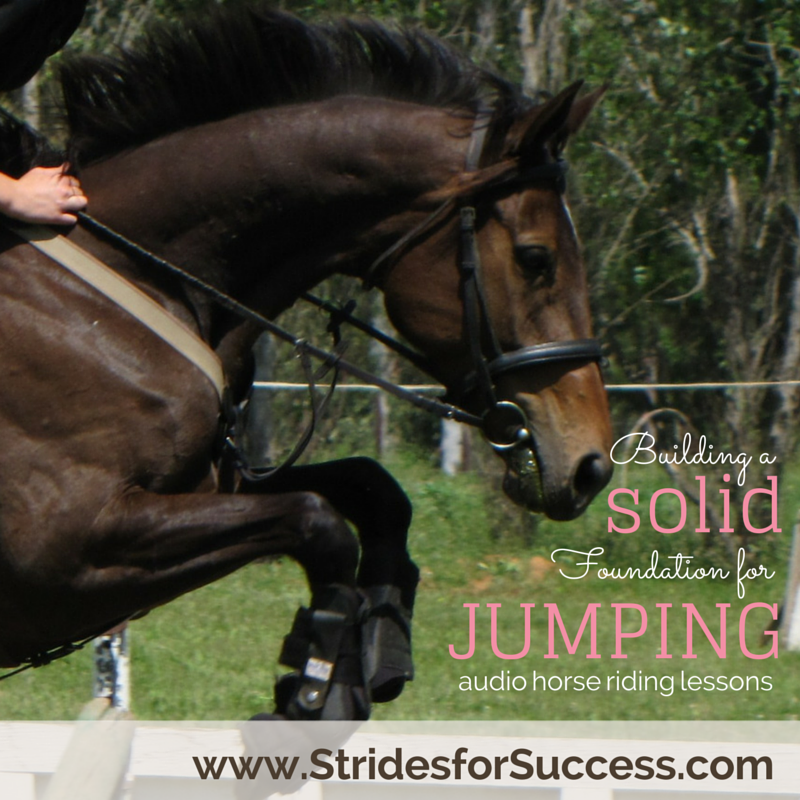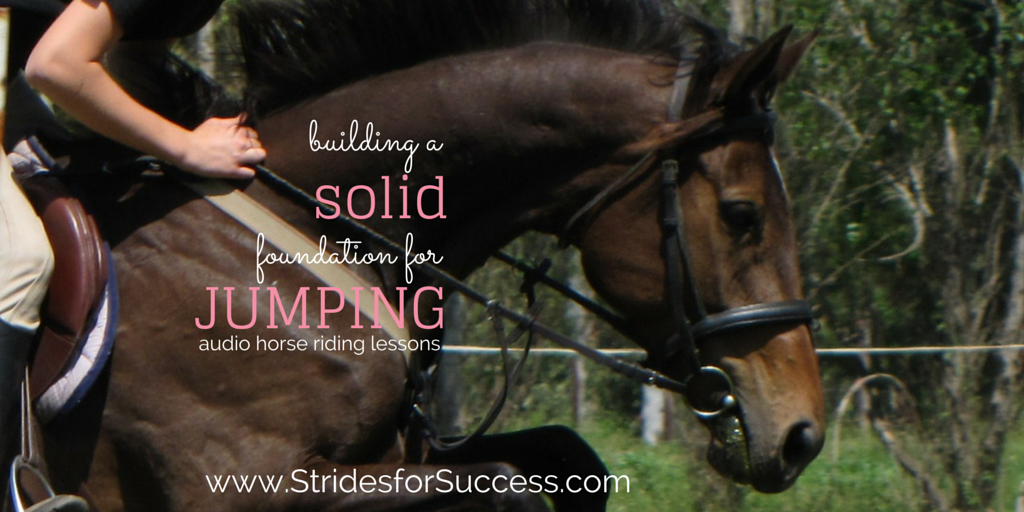Jumping, it has the ability to thrill and to strike fear into riders, sometimes all at once! However, if approached in a systematic and patient manner, most of the fear will dissipate allowing both you and your horse to enjoy jumping; whether it be a pop every now and then, or a trip round a course of fences weekly at a local show.
Generally speaking, all horses can jump, however some horses have more jumping ability than others and it is important to work with your horses natural ability and focus on improving it using a specifically tailored program.
We should also remember that some horses no matter how much time and effort is invested in their training, just don’t enjoy jumping and that must be respected as well. Be sure that your horse enjoys the task as much as you do!

In order to produce a horse that is both safe and competent over fences his jumping schooling must be combined with basic flat work or dressage schooling to develop suppleness, balance, strength and agility.
The stronger the horse, the better he can use himself and his natural ability. Strength takes time to develop and pushing your horse before he is physically or mentally ready will potentially cause him to become tense or anxious about jumping which can show itself in a whole host of problems, from rushing to running out.
The key to building a solid foundation is to develop confidence; both your horse’s and your own. This confidence will ensure relaxation through your horse, which will soften the neck, back and body in general so it can be used correctly and fully both between and over fences.
Also in jumping, timing is everything however in order to time correctly, there needs to be a few key pieces in place first, namely; Rhythm, straightness, balance and impulsion. If anyone of these parts are missing, the likelihood of a smooth, successful jump diminishes greatly.
Firstly, lets begin by looking at you, the rider.
Before you begin jumping I strongly recommend that you have an independent seat. A quick ‘challenge’ you can do to test this is having the ability to hold the 2 point seat for at least a couple of laps of your arena without falling over, your legs swinging or collapsing on your horses back. This sounds easy enough, however 30 seconds in your body will know all about it…!
I also suggest using this quick and simple exercise while out on hacks or trails; pick different markers such as trees, shadows of telephone poles, fence posts and pretend they are a jump. Begin trying to judge where your horse would take off and being able to ‘slip’ into your jumping position when necessary. You can initially do this in walk, then in trot and, if you have a grassy bridle path or somewhere else suitable, in canter also.
You can then take it one step further by beginning to see if you can adjust the ‘take off point’ for your horse and use that accordingly. I find doing this exercise really helps you ‘feel’ what a balanced jumping position is like, helps you quickly adjust your body in and out of the jumping position and also helps to begin training you to ‘see a stride’.
Back in the arena a really useful and extremely versatile exercise can be ridden by placing a single pole on the center line at X and working over it in a similar fashion. Test yourself initially in walk to see how straight you can make your approach and then, once successful, move onto trot and, later, canter. See if you can judge the take off point and adjust your position to suit this accordingly.
This exercise is always a good exercise to come back to when ‘tuning up’ both you and your horse. You can also begin improving your ability to ‘see a stride’ by counting backwards the last three strides to your take off point, “3,2,1 Jump”, and when more experienced, “5,4,3,2,1 Jump”.
Once mastered, the pole can be ‘popped’ from different angles, all the while making sure you remain riding on a straight line of your choice. Imagine two long narrow triangles, their points touching at the pole to create a long angular figure of 8. Ride each line, popping the pole each time at an angle and then balancing your horse around the ‘turn’ at the top of each triangle to come back on the opposite line.
Again, begin at walk, choose your line or path and once mastered take up trot and then on to canter.
Secondly, it is important as a rider to allow your horse to ‘figure things out’ for himself.
I know myself how tempting it is to interfere and ‘help’ but this will only lead to problems further down the line when your horse cannot get himself out of trouble. At some point in your riding, you will inevitably get it ‘wrong’ and you need your horse to firstly realize this has happened and secondly to make a plan of his own to get you both out of trouble.
This comes more naturally to some horses than others, however you can also begin to teach your horse this invaluable skill by not interfering.
I personally think one of the most difficult things to do on a horse is nothing! However, as riders we sometimes must do just this!
In the arena, use simple grids to work on both you and your horse, separately and together, to grow your skills over bigger more demanding fences. Make sure that you are guiding your horse all the way through the grid, however that you are also allowing him to see that adjustments must be made and to actually make the adjustments himself. Often horses pull through fences only because the rider is pulling through the fences. You need to disengage and allow your horse to jump the jump.

This also means being balanced over the fence, not throwing your weight about and not depending on your horses neck, body, mane, reins etc for your balance and support, which we spoke about earlier.
The hours spent practicing over the smaller fences will ensure you can both successfully negotiate a course of larger fences when the time is right.
Lastly, you can begin to improve both you and your horses effectiveness and technique
Once both of you are confident, you can then begin looking at improving your style and effectiveness and your horses technique and skills. However, again, this can only really begin when the foundation has been properly cultivated and developed.
You can do this using grids that ask more questions of your horse, such as bounces, shorter distances, longer distances, angles, bends, types of fences. The list is endless and different elements will be more beneficial to improve specific parts of your horses technique.
At the end of the day, you are looking for the best way to allow your horse to really reach his full potential in a happy safe manner.
Horses should not be jumped every day. Remember most of the time spent jumping a round of fences is actually spent on the flat, between fences. Use this ratio when creating your training program for your horse.
Also remember that if you can negotiate the smaller fences easily, the larger ones won’t prove a problem… However anyone can get from A to B over a small fence… Getting there correctly and with style is what counts.
Invest your time training over the smaller fences and less complicated grids and return there regularly as often bad habits slip in when least expected and only every now and then, test your knowledge and skill over larger fences.
Happy Jumping!
Lorna
[wp-tiles post_type=”post” orderby=”date” order=”DESC” grids=”News”]
